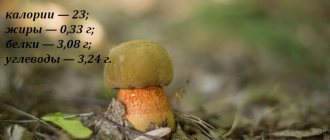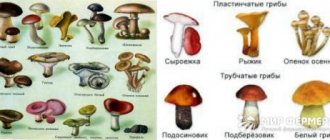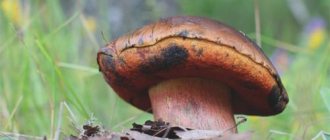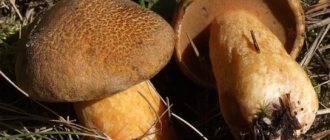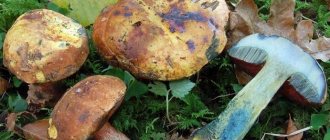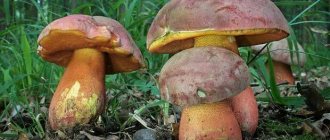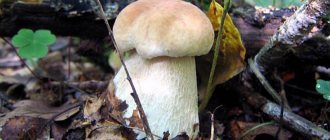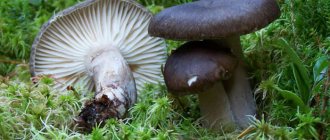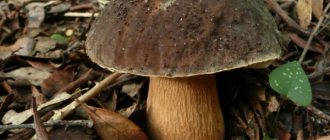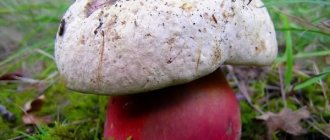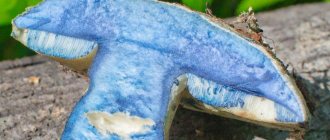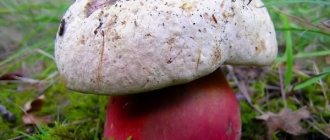Olive-brown oakberry is an edible heat-loving species. The mushroom is beautiful, large with a thick, fleshy cap and a massive stalk. Belongs to the genus Boletus of the Boletaceae family, tubular group. Conditionally edible.
Most boletes are large mushrooms. The diameter of the cap, for example, of a porcini mushroom can reach 50 cm. At the same time, the height of the stem is 25 cm, with a diameter of 15 cm. Collecting such giants is a pleasure. One copy is enough not only to prepare dinner, but also for more than one dish. Fruiting bodies weighing 500 grams are far from uncommon. True, they usually give preference to young mushrooms, since mature ones are affected by insects and worms.
Bolets can boast not only of size, but also of outstanding external characteristics: a dark, fleshy cap on a thick light stalk. It is impossible not to notice such beauties, no matter how much they try to hide among the grass or under fallen leaves. At the same time, the taste qualities of these mushrooms are very high and are appreciated by lovers of mushroom cooking.
Just like the closest species, olive-brown oakberry forms large, fleshy fruiting bodies. The maximum diameter of the mushroom cap can be 20 cm. The height of the stem reaches 15 cm with a diameter of about 6 cm.
It has the greatest external resemblance to the king of mushrooms - the porcini mushroom, with which it is often confused when collected, especially by beginner mushroom pickers. The main distinguishing feature of olive-brown or common oak is the flesh that turns blue when cut. And the taste qualities of this representative of the mushroom kingdom are much more modest.
Although it is believed that in the CIS, olive-brown oak is a fairly common plant and can be found even at the latitude of St. Petersburg, but these are isolated specimens. The mushroom is thermophilic and gravitates to the south.
The beneficial properties of olive-brown oak include the fact that, unlike many types of mushrooms, the fruiting season of which begins in late summer and autumn, this species, depending on the region, can be harvested as early as June and even at the end of May. This allows lovers of mushroom cooking to enjoy this mushroom fresh for a longer time.
Unlike the prolific and ubiquitous honey mushrooms, the oak mushroom does not form numerous colonies. Also, there are no extensive families like witch circles. However, it compensates for this disadvantage with its size.
As for the taste properties of olive-brown oak, opinions vary: some authors believe that the taste and aroma are weakly expressed. Others believe that the mushroom in its finished form is aromatic and tasty. All that remains is to collect these mushrooms yourself, prepare a culinary dish from them and try them to form your own opinion.
Olive-brown oakberry is a conditionally edible mushroom. Therefore, it requires mandatory additional pre-culinary processing. There are contraindications for use.
The pulp is thick and dense. It retains its texture well during cooking and does not fall apart. It can be used universally in cooking. The mushroom has shown itself well in a variety of preparations for the winter, including canning. But the benefits of olive-brown oak are not limited to this.
This species is a valuable food product. The chemical composition of olive brown oak contains vitamins (thiamine, riboflavin, nicotinic and ascorbic acids, etc.), macro- and microelements (calcium, iron, magnesium, phosphorus, etc.), other biologically active substances, including the amino acids tryptophan, threonine, lysine.
In addition, olive-brown oakberry has medicinal properties. During scientific research, the substance boletol was isolated from the fungus, which has a pronounced antibiotic effect against a number of bacteria.
For the purpose of prevention, regular consumption of dishes with dubovik has a beneficial effect on the functioning of the cardiovascular system, protects the heart and reduces the risk of angina pectoris, normalizes blood pressure, activates the thyroid gland, removes waste and toxins from the body, and strengthens the immune system.
Olive-brown dubovik is a useful product for men's health - it increases potency. Also, the substances in the mushroom help improve the condition of the skin, hair, and nails.
Important! The information presented in the material is for informational purposes only. Be sure to consult an experienced professional before use.
Oak tree is olive-brown. Latin name : Boletus luridus.
Oak tree is olive-brown. Other names : common oakweed, oakweed, poddubovik, underdubovik, dirty brown, bruise.
Information! In addition to olive brown oak, the popular name “bruise” also has:
- Polish mushroom (Boletus badius) – genus boletus or boletus (Boletus) of the Boletaceae family;
- blue gyroporus (Gyroporus cyanescens) - genus Gyroporus or Gyroporus of the Gyroporaceae family;
- speckled oak (Boletus erythropus) is a genus of boletus or boletus (Boletus) of the Boletaceae family.
But these are different types of mushrooms.
Related species
The olive-brown oak tree has many relatives: the boletus or boletus genus is quite numerous and includes about 300 species, among which there are both edible, conditionally edible, and inedible
Edible species include:
- maiden boletus (brown-yellow boletus) – Boletus appendiculatus;
- bicolor boletus – Boletus bicolor;
- Burroughs boletus – Boletus barrowsii;
- Fechtner's boletus – Boletus fechtneri;
- semi-white mushroom – Boletus impolitus;
- yellow boletus (yellow boletus) – Boletus junquilleus and others.
The group of inedible, toxic and poisonous species includes:
- beautiful boletus (beautiful boletus) – Boletus calopus – inedible;
- Boletus porosporus (Boletus porosporus) – inedible;
- purple boletus (pink-purple boletus) – Boletus purpureus – inedible;
- legal boletus – Boletus legaliae – toxic;
- beautiful boletus - Boletus pulcherrimus - toxic;
- satanic mushroom – Boletus satanas – toxic, etc.
Similar species and false look-alikes
During a “silent hunt”, the ability to recognize each individual type of mushroom and distinguish it from similar edible species is of great importance. But the most important thing is to learn to distinguish it from inedible and poisonous mushrooms that are similar in appearance, which can harm not only health, but sometimes even human life.
How to distinguish
Olive-brown dubovik is a fairly common mushroom. It has a fairly typical appearance for boletaceae - representatives of the genus boletus or boletus. And there are quite a lot of mushrooms with which it can be confused when collected. Among them there are both edible, conditionally edible, and inedible and even poisonous.
Since boletes have similar external characteristics, the closest related species of olive-brown oak are the first similar species or doubles of this mushroom. The exception is the inedible gall mushroom.
Each mushroom has its own distinctive characteristics. Here, first of all, you should carefully study the photo and botanical description of the olive-brown oak and each of the species similar to it.
And if edible doubles can be given less attention, since they can be eaten. Mushrooms can only differ in the subtleties of pre-processing and use in cooking. The study of inedible species must be taken seriously.
Similar edible species
Speckled Oak - Boletus erythropus
Most often, the twin of the olive-brown oak is the speckled oak. Another name: boletus boletus (grain-legged). The mushroom is edible. Some sources, due to the need for a mandatory preliminary fifteen-minute boiling, classify it as conditionally edible. Distinctive features of this type are:
- The color of the cap, although similar, is brown, but brighter and more saturated. Olive and reddish tints may also be present.
- The leg is covered with red scales or dots, unlike the olive brown oak, which has a reticulate pattern.
- It grows both in forests and in swampy areas.
Information! The fruiting season of speckled oak is May-October. It grows most abundantly in July.
White mushroom – Boletus edulis
Also similar to the olive-brown oak mushroom is the porcini mushroom - its varieties. And although these two mushrooms are quite similar in appearance, especially from afar, there are quite a lot of differences. The distinctive features of the porcini mushroom are as follows:
- When you press on the cap, the color does not change - the olive-brown oakberry cap first turns blue, and then quickly becomes black-brown.
- The color of the tubular layer in young mushrooms is light, white, sometimes with a pinkish tint; as they grow, it changes to yellow, and then greenish, olive green. While the oak mushroom has an olive-brown pore color, the pores of adult mushrooms are orange, reddish, brick-red. When pressed, the pores turn blue.
- The leg is noticeably lighter - white, light cream, beige, in contrast to the olive-brown oak, which has reddish shades - yellow-orange, at the base the leg is red-brown, wine-red.
- There is a network of thin light lines on the leg - the olive-brown oak has a red network.
- The pulp is white, yellowish. When cut or broken, the color does not change.
Information! The white mushroom bears fruit from late May to early November. The peak of growth occurs in the second half of August - the first half of September.
Kele's Oak – Boletus queletii
A mushroom with a controversial reputation: some authors classify it as inedible. Others believe that this species is conditionally edible and can be eaten after mandatory additional pre-culinary processing.
Information! Fortunately, despite having a controversial reputation, the Kele oak is quite rare and widespread in the Caucasus, and less often in the Far East.
There are few differences between the Kele oak and the olive-brown oak:
- The hat is chestnut brown.
- The color of the leg is the same throughout its height - yellow-brown.
- The typical olive-brown oak tree has no mesh pattern on the stem.
- The flesh is yellowish, the stem is brownish.
- It grows exclusively under deciduous trees and never under coniferous trees.
Information! The Kele oak tree bears fruit from May to September.
Polish mushroom – Boletus badius
Some classifications place this species in the genus Xerocomus or Imleria. Another name is Polish porcini mushroom, Pansky mushroom. Edible. Like porcini mushroom, it has high taste qualities. Unlike olive-brown oak:
- The color of the cap, although similar, is noticeably darker - reddish, chestnut, brownish brown.
- The leg is also unevenly colored - the color is yellow, light brown, light, yellow-brown, with lighter upper and lower parts, but in olive-brown oak it has reddish shades.
- The leg is smooth, covered with red-brown fibers - olive-brown oak has a mesh.
- The color of the pulp is whitish, light yellow. When cut, the cap first turns slightly blue, then becomes light again, the legs first turn blue, then turn brown.
- The taste is soft, slightly sweet. The smell is pronounced, pleasant, mushroom, sometimes there are fruity notes.
Information! The Polish mushroom grows from June to November.
Inedible look-alikes
Unfortunately, the olive-brown oak species has dangerous lookalikes with which it can be confused when collected and which, if eaten, can cause serious harm to health.
Pink-skinned boletus – Boletus rhodoxanthus
Another name: pink-golden boletus. Another species with a controversial reputation. Some authors believe that the mushroom is poisonous and not suitable for food. Others believe that it is edible and can be eaten, but only after careful additional pre-cooking processing.
However, it must be remembered that pink-skinned boletus should be introduced into your diet with caution, starting with small volumes and gradually increasing the amount eaten at one time.
Carefully! In its raw form, the pink-skinned boletus is poisonous.
There are not many clear and unambiguous differences between the pink-skinned boletus and the olive-brown oak. Rather, they are noticeable when comparing the two species in the photo. This type can be distinguished by:
- The color of the cap varies from brownish-gray to dirty, brownish-yellow, with reddish shades closer to the edge.
- The stalk of adult mushrooms is cylindrical, often noticeably pointed at the base. Painted in brighter, richer shades of red.
- On the stem there is a bright red mesh pattern, which in young mushrooms is looped, later becomes elongated and dotted.
- The pulp is lemon-yellow, bright yellow near the tubes and in the stem, wine-red closer to the base. When cut, it turns slightly blue.
Information! The pink-skinned boletus bears fruit from June to early October.
Gall mushroom – Tylopilus felleus
Belongs to the genus Tylopilus of the Boletaceae family. Other names: false porcini mushroom, false boletus, bitterling. Inedible.
The mushroom is not poisonous, but it is also not suitable for food, since the taste of its pulp is very unpleasant, bitter, acrid, and does not disappear when cooked, but only intensifies. Even a small piece of a false porcini mushroom can ruin the entire mushroom dish or preparation.
Compared to the olive-brown oak fungus, the gall fungus has:
- The hat is light in color - gray-ocher, yellow, grayish-brown, yellow, light brownish.
- The color of both the tubes and pores in very young specimens is white, then as they grow it becomes pinkish, dirty pink. Turns red when pressed.
- The leg is light - creamy-ocher, yellowish, ocher-yellow, yellow-brown, whitish in the upper part, creamy yellow.
- The color of the pulp is white; when cut, it changes to pink, pink-brown, or reddish.
- The taste is bitter.
- It can grow on the roots of not only living trees, but also near rotten stumps and on rotten wood.
- There are no insects on the surface, as they are not attracted to its bitter taste.
Information! The fruiting season of the gall fungus is from June to October.
Satanic mushroom – Boletus satanas
Another name: satanic pain. A mushroom with a controversial reputation. There are a lot of opinions about its edibility or inedibility and they are quite contradictory: on the one hand, in some European countries, such as the Czech Republic, France, etc., this mushroom is considered conditionally edible and must be eaten after additional preliminary processing. On the other hand, Gerard Oudou in his book “Mushrooms. Encyclopedia" classifies the satanic mushroom as poisonous.
Some authors believe that long-term boiling deprives the mushroom of most of its toxins, however, it is not recommended to eat it.
Carefully! In its raw form, the satanic mushroom is highly poisonous: about 1 gram. pulp can cause severe digestive upset.
You can recognize this type by:
- The cap is whitish, grayish, dirty, olive-gray, sometimes with a yellowish or ocher tint; greenish or yellow-pink stains may be present.
- The leg is noticeably thicker. At a young age, it is ovoid, spherical, and as it grows it gradually changes to tuberous, barrel-shaped or turnip-shaped - narrowed in the upper part.
- The color of the stem of a mature mushroom is yellowish-red at the top, carmine-orange-red in the middle, and brownish-yellow at the base.
- The flesh of the cap is white, yellowish, and when cut, turns red or moderately blue.
- The smell of older specimens is reminiscent of rotten onions.
Information! The satanic mushroom bears fruit from June to September.
Le Gal boletus – Boletus legaliae
Another name: legal boletus. The mushroom is toxic: if eaten, it can lead to gastrointestinal ailments.
There are not many striking and convincing differences between Le Gal's boletus and olive-brown oak. Rather, they are noticeable when comparing the two species in the photo. What is the difference between the Le Gal boletus and the olive-brown oakweed:
- The color of both the cap and the legs is pink-orange.
- The leg at the top is covered with a red mesh pattern.
- The size of the mushroom is noticeably smaller: the diameter of the cap can reach a maximum of 15 cm, the height of the stem is 12 cm.
Information! Le Gal boletus grows from late summer until persistent cold weather.
Botanical description
hat
The olive-brown oak cap is round, massive, thick, fleshy. In young mushrooms it is hemispherical, as it grows it gradually opens and becomes convex, cushion-shaped in mature specimens. A flat cap is extremely rare.
The skin is matte, initially velvety or slightly pubescent, later bare. Dry, mucous in damp and humid weather.
The color is uneven and varies widely from light, brownish-yellow, yellow-orange to dark, olive-brown, olive-brown, red tones may be present. At the same time, the edges of the olive-brown oak cap are sometimes reddish-yellow. With age it sometimes darkens to black-brown. When pressed, it first turns blue, and then the color quickly changes to black-brown.
Diameter: 5-15, up to 20 cm.
Hymenophore
The hymenophore of the oak tree is olive-brown (the lower part of the cap) - the tubes at the stem are notched or free. The length of the olive-brown oak tubes: 1.5-3.5 cm. The color changes as the mushroom matures: in young fruiting bodies it is yellow, ocher, then it becomes greenish-yellow, greenish, olive, to dirty olive in older mushrooms.
The pores are very small and round. The color is initially yellow, later changing to orange, reddish, brick red. They turn blue when pressed.
When the cap is cut across, a reddish pigment layer is visible, located between the flesh of the cap and the tubular layer of the olive-brown oak.
Spores are smooth, fusiform, ellipsoid. Color: honey yellow. Size: 11-16 x 5.5-6.5 microns. The color of oak spore powder is olive-brown: olive, brown, olive-brown.
Leg
The leg is central, thick, solid. At a young age it is barrel-shaped, and as it grows it changes to a club-shaped, cylindrical shape.
The color of the leg of the oak tree is olive-brown - yellow-orange, closer to the base it is wine-red, red-brown, black-brown. There may be reddish spots in the middle part and greenish spots in the lower part. Covered with a pronounced convex brownish-red mesh pattern with elongated cells.
Height: 4-12, up to 15 cm, diameter: 2-6 cm.
Pulp
The olive-brown oak pulp is thick and dense. The color is yellowish, the lower part of the stem is reddish, wine red. When cut, it changes first to blue, blue-green, then brown, sometimes to black. Without pronounced taste and smell.
General characteristics of oak trees
The mushroom, which is on the list of useful representatives of the mushroom kingdom, belongs to the Boletus species. Due to their external resemblance to porcini mushrooms, inexperienced mushroom pickers often confuse them. The diameter of the large fleshy cap reaches 20 cm. Young individuals are characterized by a hemispherical shape. As it matures, the cap becomes cushion-shaped.
When there is no rain, the surface layer of the cap is velvety, like suede. When wet it becomes sticky. The surface color is olive-brown or yellow-brown, and the tubular layer is olive-greenish. The shape of the thick stem is cylindrical, slightly thickened at the base. If you press on the pulp, it will turn blue. Due to this feature, the mushroom was nicknamed bruise.
Habitat
Olive-brown oakberry is a fairly common species. Grows in North America and Europe. Heat-loving and although it can occasionally be found at the latitude of St. Petersburg, these are isolated specimens; the main regions of distribution of olive-brown oak are in the south.
In the CIS, this species can be found in the south of Belarus, Ukraine, the Caucasus, and Crimea. In Western Siberia it is quite rare, in Eastern Siberia these are isolated territories, for example, the Krasnoyarsk Territory, where it creates an alliance with birch. Also found in the south of the Far East.
Prefers calcareous soils and low-lying areas. Grows in small groups or singly.
Where does it grow
Olive-brown oak forms mycorrhiza (symbiosis with the roots of the plant) with various tree species, but most often with oak, beech, birch, and linden.
This species can be found in deciduous, most often oak, as well as mixed forests.
Information! Olive-brown oakberry can be grown at home. To do this, you should purchase mycelium in specialized stores.
Making mushroom soup
To prepare oak wood, you need to select the desired processing option. These methods include frying, salting, boiling or adding fresh fruit to various dishes. The choice of processing option will determine how many mushrooms will be needed.
We suggest you familiarize yourself with Reproduction of spathiphyllum at home
Pickling
1 l1 hour
Nutritional value per 100 g:
- 2-3 hours before cooking, fill the mushrooms with water and wash thoroughly to remove any dirt.
- Next, boil the small fruits for 20–25 minutes.
- While they are boiling, you need to prepare the brine. To do this, you need to boil 250 ml of drinking water, then add sugar, salt and all the selected seasonings. Most often these are pepper, garlic and cloves. Simmer the spiced liquid for 10 minutes.
- Place the boiled mushrooms in a jar and pour in the solution, which has just boiled, then add 2 tbsp. l. vinegar.
- The jar should be tightly sealed and left to cool upside down.
Did you know? The most expensive type of mushroom is the truffle. The cost of a kilogram of such fruits averages $2,500.
Boiled
61 hours
pepper or garlic to taste
Nutritional value per 100 g:
- Fresh mushrooms should be cleaned and washed to remove dirt. Trim the stems to keep the cut fresh.
- Next, the prepared fruits need to be placed in a container with water and cooked for 10–15 minutes.
- After this, they need to be drained and boiled again in clean water for another 15 minutes. After boiling again, you need to catch the fruits from the broth and leave to cool for 25 minutes.
Fried
640 minutes
fresh oak mushrooms 2 kg
Nutritional value per 100 g:
- Wash the fruits thoroughly and cut into slices or oblong strips.
- Place the prepared fruits on a heated frying pan and cover with a lid.
- After the mushroom juice has evaporated for 15–20 minutes, add 200 ml of sour cream and mix thoroughly. Leave on the fire for 5-10 minutes, then add pepper, salt and grated garlic. Fry all this for a couple more minutes and let cool. This dish can be served with porridge or pasta.
Did you know? During an inspection in 2002, mushrooms were found at the Chernobyl nuclear power plant reactor. Radiation did not harm them, and after research it became clear that it was necessary for survival, like the sun for plants.
How to collect
This species begins to bear fruit depending on the region, and forms so-called layers or waves of fruiting. The first mushrooms can be found already in June and even at the end of May. But usually stable growth in most regions where olive-brown oak is common begins in July.
Then the mushroom disappears. The second, more massive, wave of fruiting begins in mid-August and lasts until October - early November. The peak occurs in August.
Where to collect
The mushroom prefers bright, well-warmed places by the sun. In the literature you can read that it grows singly or in small groups, but in some areas this species can form quite numerous families.
Important! Mushrooms tend to accumulate all kinds of toxins and heavy metals from the soil. Therefore, to harvest olive-brown oak, you need to choose environmentally friendly places, away from industrial enterprises, roads, etc.
Beneficial features
The mushroom is distinguished by a rich and varied chemical composition, which includes proteins, fats, carbohydrates, minerals, vitamins and other substances. The composition (per 100 g of product) includes:
- 92.5 g water;
- 3.08 g protein;
- 0.36 g of fat (including 0.06 g of saturated fatty acids, 0.14 g of polyunsaturated fatty acids, 3 mg of campesterol);
- 3.28 g of carbohydrates (including 1.45 g of glucose and 0.19 g of fructose);
- 0.9 g of inorganic substances.
The mineral composition per 100 g of fresh mushrooms is very rich and includes:
- 320 mg copper;
- 317 mg potassium;
- 84 mg phosphorus;
- 10 mg magnesium;
- 4 mg calcium;
- 4 mg sodium;
- 0.6 mg iron;
- 0.55 mg zinc;
- 0.046 mg manganese;
- 9.4 mcg selenium.
The vitamin composition of common oak is no less rich, and it is presented per 100 g:
- 17.5 mg choline;
- 9.3 mg betaine;
- 3.609 mg niacin;
- 2.2 mg ascorbic acid;
- 1.495 mg pantothenic acid;
- 0.404 mg riboflavin;
- 0.106 mg pyridoxine;
- 0.082 mg thiamine;
- 0.06 mg tocotrienol;
- 0.04 mg tocopherol;
- 18 mcg folic acid (folate);
- 2 mcg dihydrophylloquinone;
- 0.5 mcg calciferol;
- 0.04 mcg cyanocobalamin; .
Podpodubnik mushroom contains many amino acids necessary for the body:
- 0.033 g tryptophan
- 0.105 g threonine
- 0.078 g isoleucine
- 0.13 g leucine
- 0.104 g lysine
- 0.034 g methionine
- 0.014 g cystine
- 0.087 g phenylalanine
- 0.042 g tyrosine
- 0.235 g valine
- 0.074 g arginine
- 0.055 g histidine
- 0.198 g alanine
- 0.198 g aspartic acid
- 0.345 g glutamic acid
- 0.093 g glycine
- 0.072 g proline
- 0.096 g serine.
The mushroom contains many useful substances
Such a rich chemical composition determines the benefits of poultice:
- Destroys bacteria through the presence of the antibiotic bolethol, fights nausea, dizziness and general weakness.
- Optimizes cardiac activity, because it significantly strengthens the myocardial muscles, evens out the rhythm, reduces the risk of angina, ischemia and other diseases. Poddubovik is useful to use for hypertension, because it contains potassium and magnesium.
- Removes toxic compounds from the body by neutralizing the negative effects of radionuclides, heavy metal salts, and pathogenic bacteria. In addition, bovine substances reduce the level of cholesterol in the blood, which significantly reduces the risk of atherosclerosis, stroke, thrombophlebitis and heart attack.
- Stimulates the functioning of the immune system, improving the condition of epidermal derivatives: hair, nail plates, etc.
- It slows down the aging process of the body due to the content of antioxidants that affect cell renewal and reduce the risk of various types of neoplasms.
- Optimizes the functioning of the central nervous system, preventing the emergence and development of neuroses.
- Stimulates healing of wounds, and also significantly alleviates the course of dermatological diseases, improves the condition of the skin in general.
- Increases potency, improves libido, sperm quality and sexual activity of men, and also prevents prostate diseases.
- Helps the body effectively fight toxins, heavy metal salts and other unsafe compounds that enter the body from the environment.
- Copper, which is part of the mushroom, stimulates the thyroid gland.
How to process
Olive-brown oak, like most mushrooms, is a perishable product and needs to be processed as quickly as possible after collection. Typically, experts determine this period as a maximum of one day. However, it should be taken into account that if the fruiting body contains small traces of rotting, as well as hidden worms, then it begins to deteriorate rapidly and the worms infect neighboring, healthy specimens. You can extend the shelf life somewhat by placing the mushrooms in the refrigerator.
Important! The longer the mushroom is stored unprocessed, the greater the loss of nutrients in its composition.
Olive-brown dubovik is a conditionally edible mushroom. Poisonous substances are found in raw fruiting bodies, which, when properly boiled, are destroyed, and the mushroom can be safely used to prepare various dishes.
Mandatory preliminary boiling before the main culinary processing applies to all methods of using oak wood. The exception is drying, which, however, does not rid this mushroom of toxins. It will also need to be boiled before cooking.
Carefully! It is prohibited to eat olive-brown oakberry in its raw form. Raw or insufficiently cooked mushrooms, when eaten, can cause indigestion. It is also not recommended to combine dishes containing common oakberry with alcohol.
Fans of mushroom cooking, when they first become acquainted with this species, are interested in how to cook olive-brown oak mushroom correctly.
After sorting, cleaning and washing, which are standard for all boletaceae, the fruiting bodies are cut into pieces and placed in boiling salted water. Bring to a boil and simmer over medium heat for 10-12 minutes. – for subsequent frying for 20 minutes.
The water is drained, the mushrooms are placed in a colander and washed well - preferably under running water. Then immerse in a new portion of boiling water and after boiling, boil for another 20 minutes. The mushrooms are drained in a colander. The broth is drained and not consumed.
Information! When boiled, the olive-brown oak pulp retains its blue color. If you add a small amount of citric acid to the water, the mushroom brightens and looks beautiful and appetizing.
Boiled oaks prepared in this way are ready for basic culinary processing.
About the edibility of oak trees
The fruiting body of the mushroom has fleshy pulp and a delicate aroma. For culinary purposes it is used for marinade and pickling. It is very popular among gourmets. Mushrooms are fried with the addition of various creamy sauces.
Dubovik can be used as a main dish, side dish, or added to soups and broths. The advantage of this product is that heat treatment does not deprive it of its beneficial properties. In addition, the fruits are almost not boiled down, maintaining their shape, which gives the dish a noble appearance. For long-term storage of mushrooms, they need to be dried or frozen, but first boiled in salted water.
The boletus body contains toxic compounds that are destroyed by heat treatment. If the product is not cooked enough, intestinal upset will occur.
How to store
Olive-brown dubovik, of course, is not a porcini mushroom, but it is quite tasty and in this regard is superior to many other species. With proper pre-cooking processing, the blue color of the pulp disappears, and the mushroom acquires an appetizing light shade. It is especially worth paying attention to the olive-brown oakberry in a year with a lean mushroom harvest. Then he will definitely help out.
The mushroom is universal, suitable for all types of winter preparations, including freezing. It has proven itself well in canning, both as a mono component and as part of vegetable stews.
The easiest and most trouble-free way to increase shelf life for use out of season is drying. In this case, there is no need to wash or boil the mushrooms first; it is enough to clean them properly. Dried fruiting bodies do not release moisture when compressed, are quite elastic, and do not crumble.
Important! Mushrooms intended for drying should not be washed.
Another fairly quick and economical way to preserve olive-brown oak for the winter is to freeze it. The result is a semi-finished product that is immediately ready for basic culinary processing. For this type of preparation, the mushrooms must be boiled first.
Important! Since repeated freezing leads to a deterioration in the quality of mushrooms, the prepared fruiting bodies should be frozen, divided into portions, so that one is enough to prepare one dish.
And, of course, the olive-brown dubovik is delicious salted and pickled, and, according to fans of mushroom cooking, it is in the pickled form that it reveals its flavor characteristics to the fullest.
Important! For salting olive-brown oak trees, only the hot method is suitable.
In cooking
Olive-brown dubovik has a pleasant mushroom taste and aroma. The pulp is thick and dense. During cooking, it retains its shape and texture well and does not fall apart.
It is universal, suitable for all cooking methods: boiled, fried, stewed. It performed well, both independently and as part of other ingredients.
Soups with this mushroom are especially tasty. Fans of mushroom cooking will also appreciate the traditional recipe - olive-brown dubovik, fried with onions and potatoes. The addition of sour cream during the frying process gives the dish a special taste. The mushroom is also used to prepare sauces.
Literature:
Aurel Dermek. Mushrooms
A.B. Polenov. Great encyclopedia of mushroom picking. We collect and prepare
Secrets of benefit
Having figured out what difference will allow beginners to collect only the necessary ingredients for tinctures or pickles, you can go on a quiet hunt.
A properly prepared dinner will delight you with its high content:
- copper;
- zinc;
- iron.
The first microelement helps stabilize digestion and also simplifies the absorption of other incoming nutritional components. The main source of zinc is the pancreas.
Copper is one of those supplements that has a beneficial effect on pituitary gland cells. This indicates the participation of the microelement in the process of hematopoiesis. And iron is an important component in maintaining hemoglobin levels at proper levels.
Even if we do not consider the qualities of specific elements, we can confidently say about the benefits of cooked pulp for the cardiovascular system.
